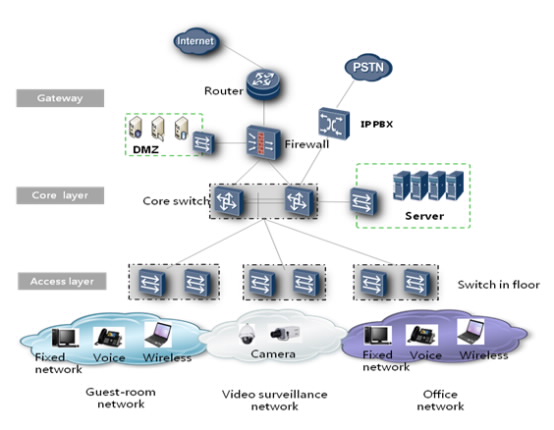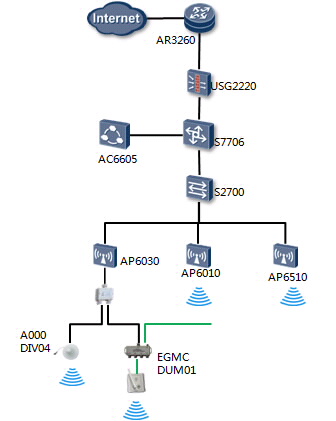Application Scenarios:
Hotels often encounter such problems as guests being unable to connect to the wireless network, eliciting guest complaints, as well as office computer virus infections, which disrupt the Performance Management System (PMS).
The Huawei basic hotel network solution integrates the wired network, wireless network, and network security, focusing on common problems and delivering a professional solution that improves hoteliers’ operational efficiency.
Solution Overview
The network adopts integration technology and hierarchical network architecture, integrating equipment, management, security, and power supply for both the wired and wireless network. The hierarchical network features a two-layer network design, an access layer and a core layer, to simplify the network. In addition, network security is fully analyzed, providing four lines of defense to ensure the hotel network is secure and stable. The Huawei basic hotel network architecture is structured as follows:

Integrated basic hotel network solution
Hotel Internet gateway
Typically hotel guest room networks and office networks have a different internet connection to separate data flow from the guest room network and the office network. A router and firewall are deployed at the network, and a DMZ area is deployed between the firewall and hotel intranet of hotel. Servers that must be accessed outside the hotel are deployed in the DMZ area. A Virtual Private Network (VPN) gateway is deployed to connect hotel groups, if needed. In addition, a billing server is required if the hotel wants to calculate Internet usage. All the previously mentioned devices are deployed in the hotel data center.
Core layer
The core layer constitutes the backbone of the hotel network, connecting the guest room network, office network, video surveillance network, DMZ area, and server area. The core layer accesses the Internet from the hotel intranet, implements Quality of Service (QoS) schedule by working with the access layer, controls visits to the server area with the Access Control List (ACL), and separates the office network and guest room network by configuring the Virtual Local Area Network (VLAN). Core layer devices are deployed in the data center.
Access layer
The access layer typically consists of Ethernet switches, which converge traffic to the core layer through a fiber or gigabit electrical interface, and connect various terminal devices to the hotel network, including personal computers, laptops, tablets, Access Points (APs), Internet Protocol (IP) cameras, IP telephones, and all types of IP devices. For analog devices like telephones, fax machines, etc., an Integrated Access Device (IAD) device is required. The access layer devices are typically deployed in equipment rooms on each floor.
Hierarchical design for reliable, fast, and stable networks
The IStack design for access layer, Cluster Synchronization Services (CSS) cluster design for the core layer, Operations, Administration, and Management (OAM) mechanism to detect link failure within 3.3 ms to ensure no disruption to hotel business.
Service-oriented HQoS for flexible bandwidth allocation
To ensure High Quality of Service (HQoS), deep service inspection prevents attacks to hotel business from BitTorrent (BT) and other illegal services. Customizing bandwidth for VIP guests and voice VLAN ensure voice services priority.
Four lines of defense to prevent hotel network virus infections
- Implementation of VLAN technology to separate guest rooms
- Deployment of Network Access Control (NAC) systems in office networks
- Separation of guest room networks and office networks and providing access control to the server area using Access Control Lists (ACLs)
- Deployment of Unified Threat Management (UTM) at the Internet border
Innovative energy-saving technologies to build a green hotel
- Compliance with IEEE802.3az standards reduces energy consumption per port by 30 percent.
- Exclusive intelligent awake-asleep energy-saving technology saves up to 40 percent of energy usage.
- Floor switches use non-fan design and natural cooling to reduce noise pollution.
- Smart Power over Ethernet (PoE) power supply and different energy management solutions for different devices maintain flexible energy management.
eSight, a unified network management system to simplify maintenance
Huawei eSight is a lightweight integrated operation and maintenance management system, which complies with standard protocols and interfaces, manages various factory devices, and provides integrated management of wired and wireless networks. A simple operation interface simplifies configuration, upgrades, and hotel network maintenance.


